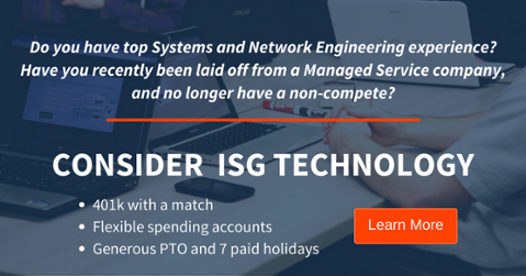Cloud types and their business applications: Public and private clouds
The cloud is absolutely revolutionizing how companies are dealing with their data needs. Data storage and processing are the key to a successful business in the modern world, and the variety of cloud storage services out there are allowing companies to take advantage of this truly amazing technology.
And while this multitude of services is certainly great in terms of providing options, deciding on which one to choose can seem like a daunting task. This technology is so new that many business owners simply don't know how it works, and as such many of them are simply opting to avoid cloud services altogether.
We at ISG Technology believe the cloud is the future of business, and we hate seeing people miss out on this truly revolutionary technology due to its seeming complexity. So, to clear up any confusion, we've put together this two-part series on what the different kinds of clouds are and what they can be used for.
Public cloud
This is a good place to start when discussing cloud managed services because it's one of the more basic options. A public cloud is where physical hardware that is owned and operated by a managed service provider in its own facility is leveraged for data storage and other uses by a paying client. These MSP-owned facilities house multiple clients, which is why they are considered "public."
The big benefit of the public cloud comes from its use of the equipment already procured by the MSP. Due to the fact that the hardware has already been paid for, and maintenance is a responsibility of the MSP, the public cloud client operates on a pay-as-you-go model that is highly scalable and extremely reliable. The infrastructure is also shared by multiple companies, which further reduces cost.
Basically, small and medium-sized businesses can get a lot of use out of the cloud. The lighter load on your budget is great for a business just starting out, and company administrators can rest easy that the equipment storing their data will be safe, as MSPs are experts at handling their hardware. These advantages are the driving force behind IDC reporting that the global public cloud computing market is expected to reach $70 billion before the end of 2015.
While there are obviously many benefits to the cloud, there are also disadvantages. The biggest of these has to do with security. Because the public cloud requires companies to share computing space, there is an increased risk of data leakage. Another client may accidently gain access to your data, or an outside hacker might gain access to it due to a vulnerability in a different company's defenses.

Private cloud
Much like its name would suggest, the private cloud allows for the same services of the cloud in a more secluded environment. All the hardware is specifically for one business, and a specialized network is set up just for them. The speed of application deployment and scalability are the same. However, a private cloud can be both on-site or off. This allows for a lot more versatility and flexibility.
The security is also miles better than its public counterpart. Because the network and hardware are specifically for one company, all the security concerns listed above aren't a problem. Another great advantage private cloud storage services have over the public variety is in terms of compliance. A company that operates in an industry with very stringent compliance standards would do well to invest in private cloud managed services because the organization can tool its cloud environment to specific needs.
However, it's not all good news in the private cloud. The main disadvantage comes from the massive cost of having your own private area of an MSP's data center. Smaller companies simply won't be able to operate entirely on a private cloud data storage model because they won't be able to afford it. This is one reason why many companies don't opt for a private cloud, as the private cloud market was estimated by Technology Business Research Inc. to be worth $41 billion in 2014.
Of course, these two models aren't all the cloud has to offer. In the next installment, we'll discuss what hybrid cloud storage services are, and why they're often seen as the better option for modern businesses.

 Keeping an in-house IT staff can be expensive.
Keeping an in-house IT staff can be expensive.



